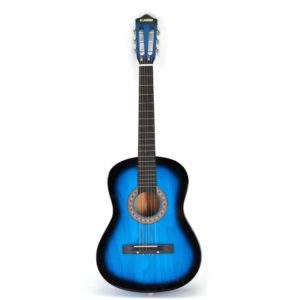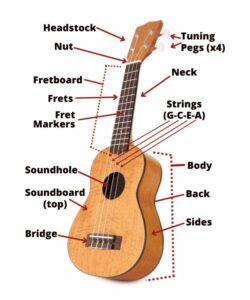Contents
- 1 4 String Bass Ukulele
- 1.1 Embracing the Unique Sound and Versatility
- 1.2 The history and evolution of the 4 String Bass Ukulele
- 1.3 The Anatomy of a 4-String Bass Ukulele
- 1.4 Advantages of playing the 4 String Bass Ukulele
- 1.5 Techniques and playing styles for the 4 String Bass Ukulele
- 1.6 Exploring different genres with the 4-String Bass Ukulele
- 1.7 Tips for choosing the right 4 String Bass Ukulele
- 1.8 Maintenance and care for your 4 String Bass Ukulele
- 1.9 Conclusion: Embracing the unique sound and versatility of the 4 String Bass Ukulele
- 1.10 Ukulele Sheet Music
- 1.11 Guide to the Types and Styles of the Ukulele
- 1.12 The Ultimate Guide to Choosing and Mastering the Acoustic-Electric Ukulele
4 String Bass Ukulele
Embracing the Unique Sound and Versatility

Are you ready to take your musical journey to the next level? Get ready to unleash the melodic power of the 4-string bass ukulele. With its unique combination of versatility and charm, this instrument is sure to captivate both musicians and audiences alike.
The 4-string bass ukulele offers a wide range of possibilities for musicians of all skill levels. Whether you’re a beginner looking to explore a new instrument or an experienced player seeking a fresh sound, this instrument has got you covered. Its compact size and lightweight design make it perfect for on-the-go musicians, while its rich and resonant tones make it a favourite among professionals.
One of the key features of the 4-string bass ukulele is its ability to produce a deep and powerful sound, similar to that of a traditional bass guitar. This allows musicians to experiment with different genres and styles, from jazz and blues to rock and pop. No matter what kind of music you’re into, the 4-string bass ukulele is sure to add a unique and captivating element to your performance.
So, are you ready to unlock the full potential of your musical talent? Discover the versatility and charm of the 4-string bass ukulele today and let your creativity soar.
The history and evolution of the 4 String Bass Ukulele
The 4 String Bass Ukulele is a musical instrument that combines the features of a bass guitar and a ukulele. It has four strings tuned to the same notes as a standard bass guitar (E, A, D, G), but with a smaller body and a shorter scale length.
The 4 String Bass Ukulele was invented in the late 2000s by Kala Brand Music Co., a company that specializes in ukuleles and related instruments. The idea was to create a bass instrument that was easy to play, portable, and affordable.
The 4 String Bass Ukulele has a unique sound that blends the low frequencies of a bass guitar with the bright and warm tones of a ukulele. It can be played with fingers, picks, or even a bow. The 4 String Bass Ukulele is suitable for various genres of music, such as jazz, blues, rock, pop, folk, and reggae. It is also popular among ukulele players who want to add some bass to their songs. The 4 String Bass Ukulele is a versatile and fun instrument that has gained many fans around the world.
The Anatomy of a 4-String Bass Ukulele

If you are interested in learning about the parts of a 4-string bass ukulele, the main components of this small but powerful instrument that can produce deep and rich tones similar to a bass guitar or a double bass. These are the main parts of a 4-string bass ukulele:
- The body: The body of a bass ukulele is usually made of wood and has a sound hole in the centre of the top. The body can have different shapes and sizes, but the most common ones are the standard and the cutaway. The standard body has both an upper bout and a lower bout, which are the widest points across the curve of the ukulele. The cutaway body has the bottom half of the upper bout scooped away to make it easier to reach the higher frets. The body also has perfling, which is a decorative and protective edge around the top and sometimes the back.
- The neck: The neck of a bass ukulele is the piece of wood that connects the headstock to the body. It holds the fretboard, which is a thin layer of wood with metal bars called frets that divide the strings into different notes. The neck also has a heel, which is the deepest part where it joins the body. The neck can be fretted or fretless, depending on your preference. Fretted necks have clear markers for each note, while fretless necks allow for more expressive playing but require more skill and accuracy.
- The headstock: The headstock is the top part of the neck that holds the tuners, which are metal knobs that adjust the tension and pitch of the strings. The headstock can have different shapes and designs, but it usually has four tuners, one for each string. The headstock also has a nut, which is a small piece of bone or plastic that guides the strings from the tuners to the fretboard.
- The strings: The strings are the most distinctive feature of a bass ukulele. They are made of polyurethane, which is a synthetic material that feels like rubber or elastic bands. They are thicker and softer than regular ukulele strings, and they produce low frequencies that can be amplified by a pickup. The strings are tuned to E, A, D, G, which is the same as a bass guitar. Some bass ukuleles also have metal round wound strings, which have a nylon core with silver-plated windings. These strings have a more familiar feel and sound for bass guitar players.
- The bridge: The bridge is a piece of wood or metal that holds the strings at the bottom of the body. It transfers the vibrations of the strings to the top of the ukulele, which then resonates and amplifies the sound. The bridge also has a saddle, which is a small piece of bone or plastic that supports the strings and affects their height and intonation.
- The pickup: The pickup is an electronic device that converts the vibrations of the strings into electrical signals that can be sent to an amplifier or a speaker. Most bass ukuleles have a piezoelectric pickup, which is located under the saddle and uses pressure to generate current. Some bass ukuleles also have a magnetic pickup, which is located near the sound hole and uses magnets to induce current. The pickup usually has a jack socket where you can plug in a cable to connect your uke to an amp or a PA system.
Advantages of playing the 4 String Bass Ukulele
If you are looking for a new musical instrument to learn, you might want to consider the 4-string bass ukulele. This is a small and portable instrument that produces a deep and rich sound. Here are some of the advantages of playing the 4-string bass ukulele:
- It is easy to learn. The 4-string bass ukulele has a simple tuning system and a fretboard that is similar to a guitar. You can easily learn the basic chords and scales and start playing songs in no time.
- It is versatile. The 4-string bass ukulele can play a variety of genres and styles, from rock to reggae, from jazz to folk. You can also experiment with different effects and techniques to create your unique sound.
- It is fun. The 4-string bass ukulele is a fun instrument to play, whether you are jamming with friends, performing on stage, or practising at home. You can express yourself and enjoy the music you make with this instrument.
Techniques and playing styles for the 4 String Bass Ukulele
The 4-String Bass Ukulele is a unique and versatile instrument that can produce a range of sounds and effects. We will explore some of the techniques and playing styles that you can use to enhance your musical expression and creativity.
- One of the most basic techniques is plucking the strings with your fingers or a pick. This can create a crisp and clear sound that is suitable for playing melodies or chords. You can also vary the tone and volume by plucking closer to the bridge or the neck, or by using different parts of your fingers.
- Another technique is slapping the strings with your thumb or palm. This can create a percussive and funky sound that is great for playing rhythmic patterns or adding some groove to your music. You can also combine slapping with popping, which is pulling the strings with your fingers and releasing them quickly to create a snapping sound.
- A third technique is tapping the strings with your fingers or a hammer-on/pull-off motion. This can create a fast and fluid sound that is ideal for playing solos or complex melodies. You can also use tapping to play harmonics, which are high-pitched tones that are produced by lightly touching the string at certain points.
These are just some of the techniques and playing styles that you can use to play the 4 String Bass Ukulele. Experiment with different combinations and see what sounds you can create. Have fun and enjoy playing this amazing instrument!
Exploring different genres with the 4-String Bass Ukulele
If you are looking for a versatile and fun instrument to play, you might want to consider the 4-string bass ukulele. This instrument is similar to a regular ukulele, but it has thicker strings that produce lower tones. You can use it to play bass lines, chords, melodies, or even solo parts. The 4-string bass ukulele is also great for exploring different genres of music, such as:
- Rock: You can rock out with the 4-string bass ukulele by playing power chords, riffs, and solos. You can also use distortion or overdrive effects to add some grit and edge to your sound. Some examples of rock songs that you can play with the 4-string bass ukulele are “Smoke on the Water” by Deep Purple, “Seven Nation Army” by The White Stripes, and “Smells Like Teen Spirit” by Nirvana.
- Jazz: You can jazz up your 4-string bass ukulele by playing complex chords, scales, and arpeggios. You can also use swing rhythms, syncopation, and improvisation to create your melodies. Some examples of jazz songs that you can play with the 4-string bass ukulele are “Autumn Leaves” by Joseph Kosma, “Blue Bossa” by Kenny Dorham, and “All of Me” by Gerald Marks and Seymour Simons.
- Reggae: You can reggae-fy your 4-string bass ukulele by playing offbeat chords, skank rhythms, and muted strums. You can also use delay or reverb effects to add some space and echo to your sound. Some examples of reggae songs that you can play with the 4-string bass ukulele are “Three Little Birds” by Bob Marley, “Red Red Wine” by UB40, and “I Shot the Sheriff” by Eric Clapton.
- Pop: You can pop-ify your 4-string bass ukulele by playing catchy chords, hooks, and melodies. You can also use chorus or flanger effects to add some depth and modulation to your sound. Some examples of pop songs that you can play with the 4-string bass ukulele are “Shape of You” by Ed Sheeran, “Can’t Stop the Feeling” by Justin Timberlake, and “Happy” by Pharrell Williams.
These are just some of the genres that you can explore with the 4-string bass ukulele. There are many more possibilities that you can discover by experimenting with different styles, techniques, and effects. The 4-string bass ukulele is a fun and versatile instrument that can help you express yourself musically in any genre you want.
Tips for choosing the right 4 String Bass Ukulele
If you are looking for a new instrument to spice up your music, you might want to consider a 4-string bass ukulele. This is a small, lightweight and versatile instrument that can produce deep and rich tones. Here are some tips to help you choose the right one for you.
- Consider the size and shape. Bass ukuleles come in different sizes and shapes, such as soprano, concert, tenor and baritone. The size and shape affect the sound quality, playability and comfort of the instrument. Generally, larger bass ukuleles have more volume and lower tones, while smaller ones have less volume and higher tones. You should choose the size and shape that suits your preference and style.
- Consider the material and construction. Bass ukuleles are made of different materials, such as wood, plastic, metal or composite. The material affects the durability, appearance and resonance of the instrument. Wood is the most common and traditional material for bass ukuleles, as it offers a warm and natural sound. Plastic is cheaper and more resistant to humidity and temperature changes, but it may sound dull and artificial. Metal and composite are more modern and innovative materials that can offer a bright and crisp sound, but they may be heavier and more expensive. You should choose the material that matches your budget and taste.
- Consider the strings and tuning. Bass ukuleles have four strings that are tuned differently from regular ukuleles. The standard tuning for bass ukuleles is E-A-D-G, which is the same as the lowest four strings of a guitar or a bass guitar. This makes it easier to play along with other instruments or to switch between them. However, you can also tune your bass ukulele differently, such as G-C-E-A, which is the same as a regular ukulele. This gives you more flexibility and creativity in your music. You should choose the strings and tuning that suit your skill level and musical genre.
Maintenance and care for your 4 String Bass Ukulele
If you love playing your 4-string bass ukulele, you’ll want to keep it in good shape for a long time. Here are some tips on how to maintain and care for your instrument.
- Clean your ukulele regularly. Use a soft cloth to wipe off any dust, dirt, or sweat from the body, neck, and strings. You can also use a mild guitar polish to make it shine.
- Change your strings when they wear out. Depending on how often you play, you may need to change your strings every few months or once a year. New strings will sound brighter and more resonant than old ones.
- Store your ukulele in a case or a gig bag. This will protect it from humidity, temperature changes, and accidental damage. Avoid leaving your ukulele in direct sunlight or near heat sources.
- Tune your ukulele before playing. A well-tuned ukulele will sound better and be more enjoyable to play. You can use an electronic tuner, a tuning app, or your ear to tune your ukulele.
Have fun with your ukulele. The best way to care for your ukulele is to play it often and enjoy it. Experiment with different styles, songs, and techniques. Share your music with others and have fun!
Conclusion: Embracing the unique sound and versatility of the 4 String Bass Ukulele

The 4 String Bass Ukulele is a unique and versatile musical instrument that combines the low tones of a bass guitar with the portability and playability of a ukulele. It can produce a variety of sounds, from mellow to funky, and can fit in different genres of music, such as jazz, reggae, rock, and pop.
The 4 String Bass Ukulele is also easy to learn and fun to play, especially for beginners who want to explore the bass range without investing in a bulky and expensive bass guitar.
